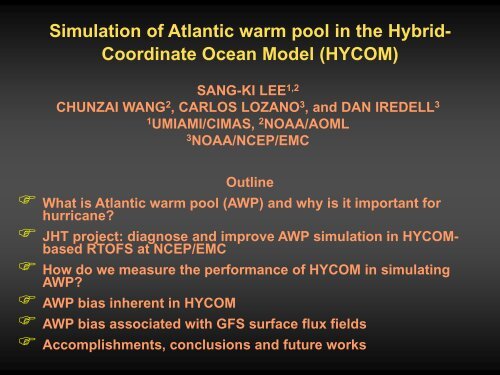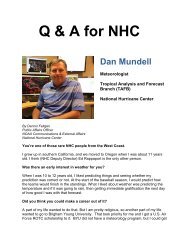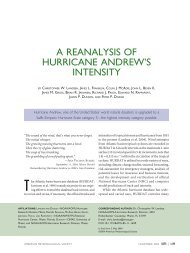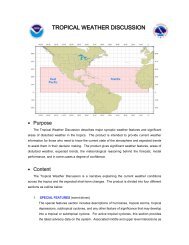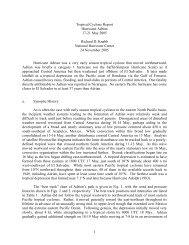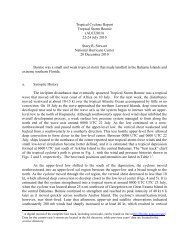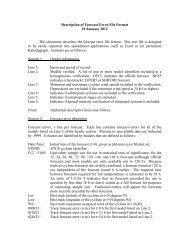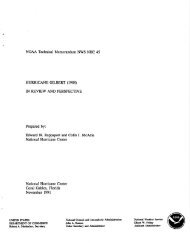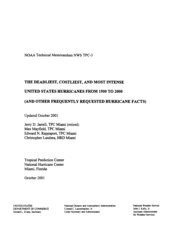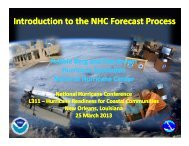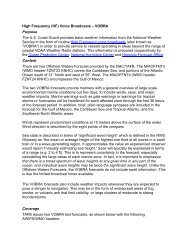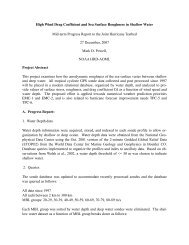X - National Hurricane Center - NOAA
X - National Hurricane Center - NOAA
X - National Hurricane Center - NOAA
Create successful ePaper yourself
Turn your PDF publications into a flip-book with our unique Google optimized e-Paper software.
Simulation of Atlantic warm pool in the Hybrid-<br />
Coordinate Ocean Model (HYCOM)<br />
SANG-KI LEE 1,2<br />
CHUNZAI WANG 2 , CARLOS LOZANO 3 , and DAN IREDELL 3<br />
1<br />
UMIAMI/CIMAS, 2 <strong>NOAA</strong>/AOML<br />
3<br />
<strong>NOAA</strong>/NCEP/EMC<br />
Outline<br />
What is Atlantic warm pool (AWP) and why is it important for<br />
hurricane?<br />
JHT project: diagnose and improve AWP simulation in HYCOMbased<br />
RTOFS at NCEP/EMC<br />
How do we measure the performance of HYCOM in simulating<br />
AWP?<br />
AWP bias inherent in HYCOM<br />
AWP bias associated with GFS surface flux fields<br />
Accomplishments, conclusions and future works
What is Atlantic Warm Pool (AWP)?<br />
<strong>NOAA</strong> ERSST2: Atlantic warm pool SST<br />
in August-September-October<br />
AWP is a body of warm<br />
surface water (≥28.5 o C)<br />
in the Gulf of Mexico<br />
and Caribbean Sea<br />
AWP appears<br />
exclusively in boreal<br />
summer and fall and<br />
disappears in other<br />
seasons<br />
Wang and Enfield (2001<br />
GRL)
What is Atlantic Warm Pool (AWP)?<br />
<strong>NOAA</strong> ERSST2: SST composites of<br />
large & small AWPs for 1854-2006<br />
Large AWPs are almost three<br />
times larger than small ones<br />
AWP has a large amplitude of<br />
variability<br />
Wang, Enfield, Lee and<br />
Landsea (2006 JCL)
Why is AWP Important for Atlantic hurricanes?<br />
Major hurricane tracks for large and<br />
small AWP years during 1950-2003<br />
MH=40<br />
MH=24<br />
AWP is significantly correlated<br />
with tropical storm indices:<br />
COR(#TS, AWP) = 0.51<br />
Large AWPs provide favorable<br />
environment for storm<br />
formation & intensification by<br />
reducing the vertical wind<br />
shear and increasing the<br />
convective available potential<br />
energy in the MDR<br />
AWP also affects North Atlantic<br />
Subtropical High, thus it may<br />
also influence storm tracks<br />
Thus, It is important to<br />
properly simulate AWP in<br />
hurricane forecast models
JHT project: diagnose and improve AWP simulation in RTOFS<br />
Real-Time Ocean Forecasting System -<br />
Atlantic (RTOFS) at NCEP/EMC<br />
RTOFS provides initial<br />
and boundary<br />
conditions for HWRF-<br />
HYCOM, which is an<br />
experimental<br />
hurricane forecast<br />
system at NCEP/EMC<br />
Both RTOFS and<br />
HWRF-HYCOM are<br />
based on HYCOM<br />
Thus, it is important to<br />
evaluate how well<br />
HYCOM simulates<br />
AWP
How do we measure the performance of HYCOM in<br />
HYCOM uses a conventional bulk<br />
formula at the air-sea interface<br />
simulating AWP?<br />
Is the simulated AWP SST<br />
a good measure of<br />
HYCOM’s performance?<br />
q 10 , θ 10 , u 10 and v 10 are fixed from observation<br />
No: If atmospheric<br />
variables are fixed, the<br />
model SST is relaxed<br />
toward observation<br />
HYCOM error is dumped<br />
into Q LHF and Q SHF.<br />
Thermodynamic<br />
inconsistency at the airsea<br />
interface may causes<br />
problems if HYCOM is<br />
coupled to HWRF
How do we measure the performance of HYCOM in<br />
Atmospheric mixed layer (AML)<br />
model is coupled to HYCOM<br />
u 10 and v 10 are fixed from observation<br />
∂θ<br />
∂θ<br />
+ u∇θ<br />
+ ω =<br />
∂t<br />
∂p<br />
∂q<br />
∂q<br />
+ u∇q<br />
+ ω<br />
∂t<br />
∂p<br />
simulating AWP?<br />
∂(<br />
ω′<br />
θ′<br />
)<br />
+ R,<br />
∂p<br />
∂(<br />
ω′<br />
q′<br />
)<br />
=<br />
∂p<br />
AML model of Seager et al.<br />
(1995) is implemented and<br />
coupled to HYCOM<br />
AML-HYCOM is an<br />
effective way to allow<br />
physically consistent airsea<br />
thermal interaction<br />
Minimize thermodynamic<br />
inconsistency at the airsea<br />
interface for HWRF-<br />
HYCOM<br />
For this study: AML-<br />
HYCOM can truly reveal<br />
the problems inherent in<br />
HYCOM
How do we measure the performance of HYCOM in<br />
simulating AWP?<br />
Optimal surface flux dataset:<br />
1) Global flux dataset of Large and Yeager (2008) provides a<br />
complete set of bias-corrected global surface flux for CORE2<br />
program<br />
2) CORE2 flux dataset is used as the optimal flux dataset to force<br />
HYCOM in this study
Three AML-HYCOM experiments (Preliminary)<br />
Three sets of surface flux datasets are used<br />
1. CORE2: 1949-2006<br />
2. NCEP reanalysis-1: 1949-2009<br />
3. GFS (RTOFS is forced with GFS): 2009<br />
Three sets of multi-year (1949-2009) surface flux datasets are<br />
prepared: NCEP reanalysis is used to fill in the missing years for<br />
CORE2 and GFS<br />
Three AML-HYCOM experiments are carried out<br />
EXP-1) NCEP1_CORE2<br />
EXP-2) NCEP1 (not shown here)<br />
EXP-3) Pseudo GFS: (We are currently evaluating)
Three AML-HYCOM experiments (Preliminary)<br />
AML-HYCOM is forced with three<br />
surface flux datasets for 1949-2009<br />
1×1 deg resolution AML-<br />
HYCOM is configured for<br />
Atlantic domain (20S-70N)<br />
on Mercator coordinate<br />
Configuration details:<br />
1) Levitus data is used for<br />
initial and boundary<br />
conditions<br />
2) North and South<br />
boundaries are relaxed<br />
toward Levitus data<br />
3) SSS is relaxed toward<br />
Levitus data<br />
4) Land regions must be<br />
tiled for AML model
EXP-1: AML-HYCOM_NCEP1_CORE2<br />
EXP-1: AWP SST is colder than observation by<br />
more than 2degC<br />
When AML-<br />
HYCOM is<br />
forced with an<br />
optimal<br />
surface heat<br />
flux dataset,<br />
AWP is colder<br />
by 2degC<br />
Thus, the cold<br />
AWP bias is<br />
likely due to<br />
model<br />
deficiency<br />
inherent in<br />
HYCOM
EXP-1: AML-HYCOM_NCEP1_CORE2<br />
It is not just HYCOM issue: Cold AWP SST bias is a known<br />
problem in fully coupled climate models
EXP-1: AML-HYCOM_NCEP1_CORE2<br />
AWP mixed layer (upper 40m) heat<br />
budget for 2009<br />
Heat budget terms are<br />
averaged over the AWP<br />
region (100W-40W; 5N-<br />
30N)<br />
Vertical mixing and<br />
vertical advective heat<br />
flux are the only major<br />
cooling mechanisms<br />
Thus, we can conclude<br />
that vertical mixing and<br />
vertical advective heat<br />
flux are too large in<br />
HYCOM
EXP-3: AML-HYCOM_PSEUDO_GFS<br />
EXP-3: AWP SST is slightly warmer than<br />
observation<br />
GFS is very<br />
different from<br />
CORE2<br />
surface flux<br />
dataset<br />
This suggest a<br />
large bias in<br />
GFS surface<br />
flux dataset<br />
We are<br />
currently<br />
evaluating this<br />
case
EXP-3: AML-HYCOM_PSEUDO_GFS<br />
AWP mixed layer (upper 40m) heat<br />
budget for 2009<br />
Heat budget terms are<br />
averaged over the AWP<br />
region (100W-40W; 5N-30N)<br />
Vertical mixing is even<br />
larger than in EXP-1<br />
Q NET is the only heating<br />
term<br />
Thus, Q NET is too large
Surface heat flux bias in GFS<br />
AWP surface shortwave heat flux for<br />
2009 suggests that GFS is not OK<br />
When compared to CORE2,<br />
GFS add up to 50W·m -2 of<br />
extra shortwave radiative<br />
heat into the AWP region<br />
This means that Q SWR is the<br />
main cause of the warm<br />
bias in EXP-3<br />
Excessive Q SWR<br />
overcompensates the<br />
excessive cooling in<br />
inherent in HYCOM<br />
associated with vertical<br />
mixing
Accomplishments, conclusions and future works<br />
Accomplishments:<br />
1) HYCOM is coupled to AML to properly diagnose and improve<br />
AWP simulation in HYCOM-based RTOFS at NCEP/EMC<br />
2) Three sets of surface flux datasets were prepared and used to<br />
carry out preliminary low-resolution AML-HYCOM experiments<br />
Preliminary Conclusions:<br />
1) When forced with an optimized surface flux dataset, AML-HYCOM<br />
produces a cold AWP SST bias of ~2degC due to excessive vertical<br />
mixing, which is a bias inherent in HYCOM<br />
2) It appears that GFS surface flux datasets put excessive<br />
shortwave heat flux into the AWP region of AML-HYCOM (We are<br />
currently evaluating this case)<br />
Future works:<br />
1) All three preliminary experiments will be repeated with RTOFS<br />
using NCEP/EMC computer resources<br />
2) AML will be fine-tuned<br />
3) Bias correction strategy will be explored
Supplementary Materials
Why is AWP Important for Atlantic hurricanes?<br />
NCAR Community Atmospheric Model<br />
(CAM3) Experiment<br />
Performed two<br />
ensemble<br />
experiments<br />
using CAM3<br />
CTRL run:<br />
CAM3 is<br />
forced using<br />
observed SST<br />
NO_AWP run:<br />
AWP is<br />
removed from<br />
SST data (max<br />
SST = 26degC)<br />
Wang and Lee<br />
(2007 GRL);<br />
Wang, Enfield<br />
and Lee (2007<br />
JCL)
What is Atlantic Warm Pool (AWP)?<br />
NCAR Community Atmospheric Model<br />
(CAM3) Experiment<br />
AWP reduces<br />
vertical wind<br />
shear (200<br />
minus 850mb)<br />
Thus, AWP<br />
increases<br />
tropical storm<br />
formation &<br />
intensification<br />
Why?
What is Atlantic Warm Pool (AWP)?<br />
NCAR Community Atmospheric Model<br />
(CAM3) Experiment<br />
AWP induces an anti-cyclone in the<br />
upper troposphere and a cyclone in<br />
the lower troposphere<br />
The atmospheric wind anomalies<br />
reduce the zonal wind in both the<br />
upper and lower troposphere over the<br />
MDR<br />
MDR vertical wind shear is reduced as<br />
a result<br />
AWP-induced wind changes can be<br />
explained by using the simple model<br />
of Gill (1980)
What is Atlantic Warm Pool (AWP)?<br />
NCAR Community Atmospheric Model<br />
(CAM3) Experiment<br />
Convective Available Potential<br />
Energy (CAPE) is a measure of the<br />
static instability of the troposphere<br />
CAPE is related to the maximum<br />
intensity of which a tropical storm<br />
can achieve<br />
AWP increases the CAPE in MDR<br />
thus more intense storms can form<br />
and develop
How do we measure the performance of HYCOM in<br />
simulating AWP?<br />
Surface flux datasets: how reliable are they?<br />
1) Taylor (2000): “There is currently no one flux climatology which<br />
does not exhibit significant errors in one region or another in each<br />
of the various flux components”<br />
2) Enfield and Lee (2005) : “The magnitude of surface net heat flux<br />
into the AWP varies by as much as 100 W⋅m -2 among eight<br />
commonly used surface flux climatologies”<br />
3) Lee, Enfield and Wang (2005): HYCOM simulated AWP SST varies<br />
by 2degC when HYCOM is forced with the eight surface flux<br />
climatologies
EXPERIMENT-2: AML-HYCOM_NCEP1<br />
EXP-2 (AML-HYCOM_NCEP1): AWP SST is colder<br />
than observation by 2degC<br />
Advective<br />
cooling<br />
related to<br />
coastal<br />
upwelling in<br />
the Southern<br />
Caribbean Sea<br />
is too large<br />
In SON, AWP<br />
center is<br />
shifted too far<br />
east
EXPERIMENT-2: AML-HYCOM_NCEP1<br />
AWP mixed layer (upper 40m) heat<br />
budget for 2009<br />
Heat budget terms are<br />
averaged over the AWP<br />
region (100W-40W; 5N-<br />
30N)<br />
Vertical mixing may be<br />
too large<br />
Vertical advective heat<br />
flux divergence may be<br />
too large<br />
Perhaps, KPP mixing<br />
scheme is not effective<br />
over AWP region?
Surface heat flux bias in GFS<br />
AWP surface net heat flux for 2009<br />
suggests that GFS is biased<br />
When compared to CORE2,<br />
GFS add up to 50W·m -2 of<br />
extra heat into the AWP<br />
region<br />
In all three experiments,<br />
the surface net heat flux<br />
into AWP is too high<br />
In EXP-1 and -2, it is due to<br />
the cold bias and<br />
associated reduction in<br />
model Q LHF<br />
Fixing HYCOM will cure<br />
this problem, but not for<br />
EXP-3
Surface heat flux bias in GFS<br />
AWP surface latent heat flux for 2009<br />
suggests that GFS is OK<br />
Q LHF of GFS is very close to<br />
CORE2<br />
In EXP-1 and -2, Q LHF is too<br />
small<br />
This is caused by the cold<br />
bias inherent in HYCOM<br />
Q LHF of EXP-3 is too large<br />
because the warm bias<br />
This means that Q LHF does<br />
not cause the warm bias in<br />
EXP-3
Surface heat flux bias in GFS<br />
AWP surface longwave heat flux for<br />
2009 suggests that GFS is OK<br />
Q LWR of GFS is very close<br />
to CORE2<br />
This means that Q LWR does<br />
not cause the warm bias in<br />
EXP-3


